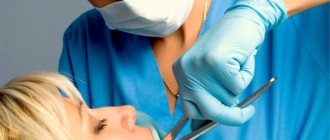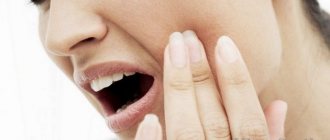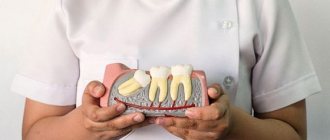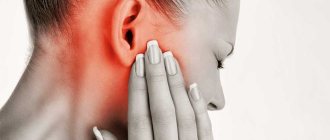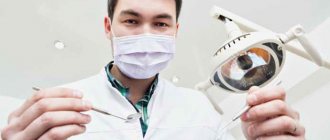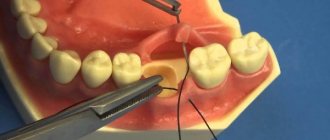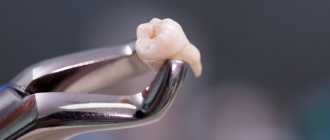Prevention measures
Failure to comply with the rules prescribed by the dentist is the second cause of complications leading to disruption of the blood clot in the socket and the onset of inflammation. In most cases, the critical factor is food that gets into the hole and destroys the clot before the tissue heals, so it is recommended to take care of prosthetics for the empty space in the dentition as soon as possible after surgery. The best option would be implantation, since it will prevent bone loss.
Immediately after surgery, doctors recommend applying an ice pack to the outside of your cheek or lip to reduce sensitivity and relieve swelling. To reduce the risk of developing alveolitis, the patient is advised to abstain from food and drinks, except water, for the first few hours after the procedure.
We suggest you read: The lower jaw hurts, why there is pain on the left or right under the teeth
During this time, you should avoid hot, solid and tough foods, as well as hot drinks such as tea or coffee. The best option would be to use liquid or semi-liquid soups and purees at room temperature. You must also follow these rules for two to four days after surgery:
- decreased physical activity;
- avoiding overheating of the periodontium and the whole body;
- avoidance of aggressive mouth rinses;
- quitting smoking and alcohol;
- careful physical handling of the socket area.
Before brushing your teeth after tooth extraction, you need to consult with your doctor, who will explain the main types of brushing movements and tell you which toothbrush and toothpaste is best to choose.
Fertilizer selection
When choosing mineral compounds for garlic, you should consider its type. Today there are 2 main varieties cultivated:
- Spring. Planting takes place in early spring. The crop is harvested in summer and eaten.
- Winter. Planted in late autumn (before winter) and intended for long-term storage.
Representatives of 2 groups need proper care. To grow them, prepare the most illuminated area where there is no stagnation of moisture. Good yields are observed when planting in beds that were used for cultivating cucumbers, legumes, zucchini and pumpkin. It is forbidden to sow garlic where onions or potatoes grew, since the plants have identical diseases.
The area for planting spring garlic is prepared in the fall. To do this, in October the bed is dug up and fertilized with special fertilizers. Their composition is determined by the characteristics of the soil:
- For a clay substrate - a mixture of urea (1 tsp), superphosphate (2 tbsp), sand, peat and humus, combined in equal proportions (5 kg each).
- For sand - humus, clay soil and urea with superphosphate. In the first case, the proportions are 1:2, and in the second - 1:3.
- Loam - the mixture requires humus, superphosphate and urea.
If the area contains a lot of peat, it is fertilized with urea and superphosphate. 8 kg of sand is also used.
Garlic responds well to fertilizing in the form of wood ash. This composition should be scattered around the perimeter, guided by the calculation of 1 liter per 1 m2 of territory. At the beginning of spring, the area is dug up and subjected to deep loosening.
Garlic. The illustration for the article is used under the standard license ©v-ogorode.ru
To prevent pest damage to the crop, the hole is watered with a salt solution. It is prepared from 3 tbsp. l. substance diluted in 10 liters of water.
Tips after tooth extraction
The tooth is pulled out, what to do next? The recommendations below will help you avoid complications.
If blood continues to flow from the wound, you need to clamp it with a sterile cotton swab and bite it. Keep it like this for about an hour.
Do not touch the clot in the socket with rough food or a toothbrush. Do not touch the hole with your tongue or touch it with toothpicks or matches.
You can eat only 2-3 hours after the operation. But food and drinks should be lukewarm. Too cold or too hot may cause bleeding to resume. For several days, you should not chew on the side of your teeth where the tooth was removed. Also, immediately after tooth extraction, you should not visit a sauna, steam bath, take a bath or shower.
If food particles get into the socket while eating, you should not try to remove them, so as not to remove a blood clot at the same time. It's better to rinse your mouth.
Rinsing is a separate matter. It is very useful, but start it only on the 3rd day after surgery, so as not to wash away the clot. Solutions such as saline, potassium permanganate, furatsilin, as well as decoctions of chamomile, calendula and sage are suitable for this.
If the pain intensifies, you can take painkillers. Before doing this, it is highly advisable to consult a doctor.
What to put in a hole with winter garlic?
The primary task of the gardener is to create the conditions necessary for garlic for a favorable wintering, subsequent germination, development and growth, in order to then reap a good harvest.
The main companions of winter garlic from the moment of autumn planting until spring are sand and wood ash, which are found in every garden plot. They have the following features:
- Sand. Garlic, like indoor plants, needs drainage so that excess moisture does not accumulate in the hole. Coarse sand is well suited for this; it is poured onto the bottom of the hole. Using this trick, you can save garlic from being in a hole with water, especially during heavy and prolonged autumn rains. The liquid will not linger in the hole, but will go through the soil. This will save the plant from rotting and ensure its safety in the garden and while maintaining the house.
- Wood ash. It is an affordable universal fertilizer; its composition is rich in useful substances such as calcium and potassium. Their presence gives the garlic clove nutrition, increases its protective properties, and helps it survive the winter before the onset of warm spring days. Thanks to the potassium content in the ash, the vegetable takes root faster and becomes stronger in the soil. Another important property of ash is soil deoxidation.
There is no way to do without ash and sand to increase productivity. Therefore, by adding just one pinch of simple, and most importantly, affordable, ingredients, you can get an exquisite harvest of winter garlic without extra costs.
fertilizing garlic / Illustration for the article is used under a standard license ©dachnyedela.ru
First steps after tooth extraction
After tooth extraction, a bandage or cotton swab is placed on the resulting hole. This is done to stop bleeding. The tampon should not be left in the hole for a long time, as it can cause the onset of an inflammatory process. Natural material soaked in blood is an excellent breeding ground for infection.
The tampon should be removed carefully so as not to remove the blood clot remaining in the wound, which promotes its healing. You should not use painkillers for more than 3 days after surgery. If the pain does not go away, you need to consult a doctor.
If the tooth extraction procedure was complicated, swelling and swelling of the soft tissues of the face may appear. You can solve the problem by applying cold to your cheek. It is advisable to do this within an hour after removal. To do this, it is recommended to use meat from the freezer wrapped in cloth or ice.
What can result from a nutritional disorder?
Violation of the diet after tooth extraction, when you can only eat soft food, leads to adverse consequences:
- Dry socket;
- Food getting into the hole;
- Mechanical damage to the edges of the wound;
- Wound infection.
Dry socket occurs when a blood clot is accidentally or intentionally removed from a wound left after surgery. In this case, an infection enters the wound and inflammation develops. In severe cases, the process can affect not only the tooth socket, but also surrounding tissues.
Pieces of food getting into the hole lead to similar consequences. Pathogenic flora quickly develops on food products. In addition, food can mechanically block the outflow of wound exudate, which does not contribute to successful and rapid healing. This is why the question of how many hours later you can eat and drink after tooth extraction is so relevant.
Another possible complication is damage to the edges of the wound by hard food. As a rule, such difficulties occur in the later stages, no earlier than 7–10 days after tooth extraction. In the early period, patients try to be careful and avoid getting solid food fractions into the wound.
zubi.pro
Lesya, please tell me how to find out if the hole is healing normally after removal.
Background: I had two wisdom teeth removed (on the left) with an interval of four days, and the second one was impacted and, as it turned out, pericoronitis had already begun around it (or pericoronitis - I don’t know for sure, and I don’t even know if there is a difference). At the same time, I did not experience any pain either before, during, or after the removal - I just came for a routine preventive examination.
The doctor, as far as I can judge, worked extremely professionally - it’s remarkable that he even discovered that something needed to be done. Before this, I visited my regular dentist at the end of July, and asked twice if everything was okay - they didn’t find anything, they just removed the plaque. And in general, my teeth have always been healthy (not a single problem with my milk teeth, caries for the first time at the age of 23, now I’m 34, only three fillings in all that time). Could such a nightmare develop in eight months?
We suggest you read: Toothache does not help, what to do
I don’t know if they cut the gum (the tooth was still visible), but they definitely didn’t put any stitches. After the first tooth was removed, everything was fine, but I was afraid to eat because of the crumbs. After the second one was removed, the temperature remained high all day; on the second day (today) she slept.
Can I determine if everything is okay before visiting the doctor? Can leftover food still get into the socket and, if it does, how can I rinse it out so as not to catch a blood clot in the socket? And how likely are complications? What can you expect in the worst case? And when should the holes finally heal (so that you can not pay any attention to them, for example, when eating), if everything goes as it should?
How to disinfect the wells (for now I just rinse carefully with saline solution)? When can I safely eat yogurt again (I was told that dairy products are not recommended after removal)? Is moderate physical activity (gymnastics, long walks) acceptable a week after removal? How to clean sevens near extracted teeth? Is it dangerous if paste gets into the hole?
I apologize for so many questions at once, but I’m really close to panic now, and I didn’t have time to ask the doctor about all this, because... After removal, it was impossible to speak because of the tampon.
I would be grateful for an answer to any of the questions!
Tooth extraction can lead to a number of consequences, including very dangerous ones. Here are some common complications:
- Abscess (accumulation of purulent masses in soft tissues), phlegmon (spread purulent inflammation), osteomyelitis of the jaw (suppuration of bone tissue). The reason is suppuration of the postoperative wound.
- Increase in body temperature to 39 degrees. The reason is the same - suppuration of the wound.
- Loss of sensitivity in the oral cavity (lips, chin, tongue) - paresthesia. The reason is a mistake by the dentist, who touched the nerve endings and internal bones. Feels like anesthesia is in effect, but without paralysis. If the damage is small, the sensitivity of the lips, cheeks and tongue will return to normal within two weeks. Otherwise, surgery may be required. Paresthesia is incurable if the nerve endings are severely injured.
- Strong pain. The reason is pieces of tooth remaining in the gum tissue.
- Alveolitis is inflammation of the socket. The reason is infection getting into the wound. Alveolitis is characterized by severe pain, redness and swelling. Bleeding, chills, malaise, weakness, headache appear, the temperature rises, and a putrid odor is felt from the mouth. The danger of alveolitis is that the inflammation can spread further.
- Flux. The reason is inflammation of the periosteum after removal. Occurs from an infection in the wound. Characterized by swelling and redness of the gums. The temperature rises and severe pain appears. Diagnosis of flux is possible after an x-ray.
- A cyst is a fibrous formation with an accumulation of fluid inside. It occurs on the inside of the cheek or on the gum. It can open either independently or with the help of a surgeon.



